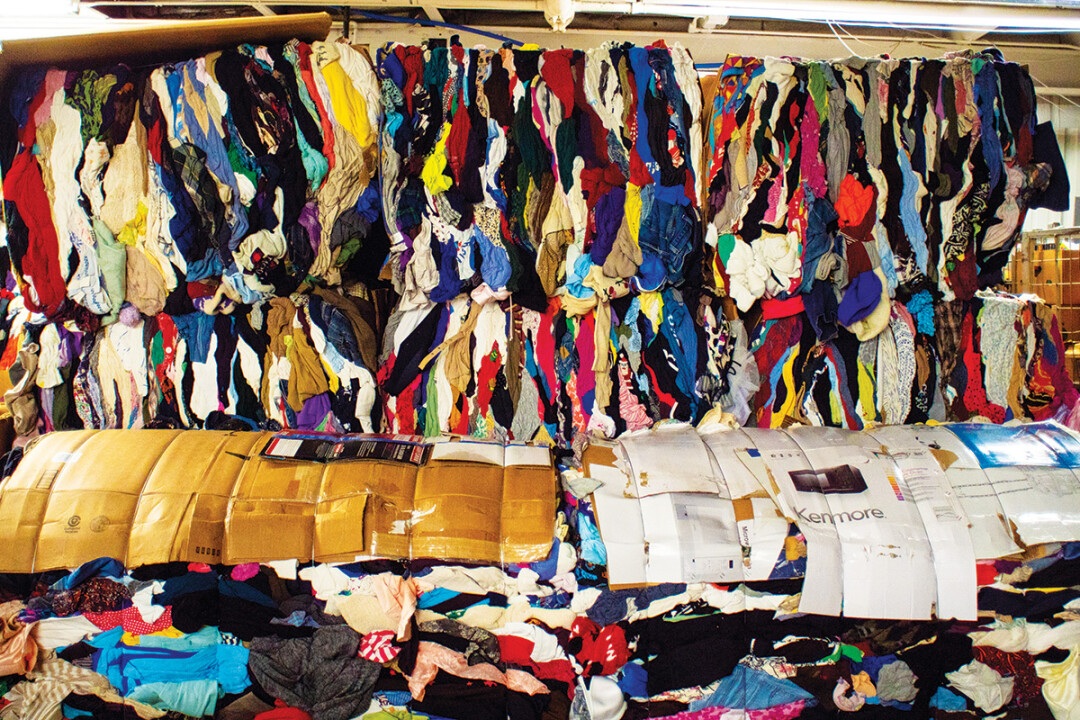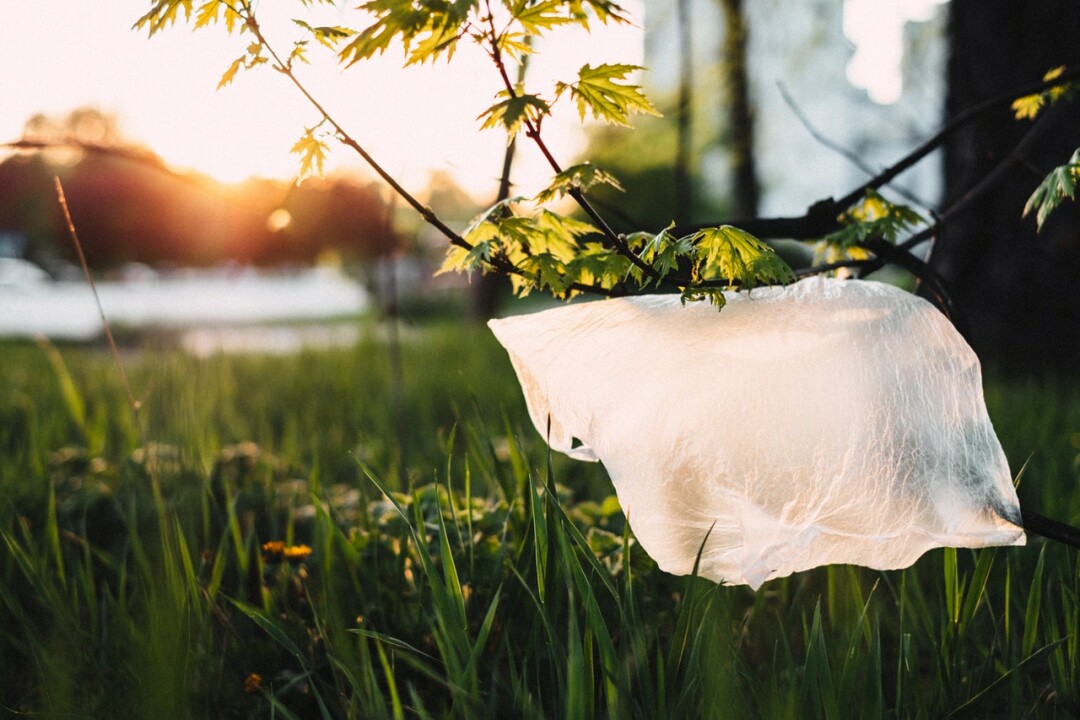How Can I Recycle That?
one woman’s mission: recycling items – old boots, a broken microwave, plastic bags – that would otherwise end up in a landfill
Katie Venit, photos by Joel Pearish

During this year’s spring cleaning, I hauled out all the things that I haven’t disposed of because I felt guilty about tossing them in the garbage: a microwave that caught on fire, old winter boots, a mountain of accumulated plastic shopping bags, and a 1999 IBM ThinkPad. If I got creative, I wondered, was there a way to recycle these items?
MISSION: WINTER BOOTS
I didn’t have a lot of hope for my winter boots. Surely, I thought, no one would accept them for recycling. But a friend mentioned that Hope Gospel Mission Bargain Center accepts textiles, even those too beat up to wear, so I thought I might as well give it a try.
Bud Drexel, business manager at Hope Gospel, met me at the donation center, which is attached to the bargain center on Moholt Drive in Eau Claire. Everything that comes through the door at the donation center is sorted into the different departments sold in the thrift store next door – clothes, shoes, housewares, basically almost everything. “If you ever need golf balls, I recommend never buying them new,” he said, gesturing towards a barrel of barely used golf balls. “We have so many golf balls.”
“If you ever need golf balls, I recommend never buying them new. we have so many golf balls.” – Bud Drexel, Hope Gospel Mission Bargain Center
Hope Gospel’s program supports their drug and alcohol addiction rehabilitation efforts, and many of the people working in the donation center are residents in the program. When they graduate, Hope Gospel gives them what they need to restart their lives, whether that be helping them find a place to live or giving them one of the donated cars to get to their jobs.
Hope Gospel won’t take donations that are health risks, like mattresses, but he said they’ll consider taking almost anything else. Between 30 and 40 percent of the donations they receive end up being sold in the store. Every week, they’re putting 5,500 new items of clothing on the floor. “It’s one of the reasons we have so many repeat customers. Our inventory on the floor is rotating constantly, so there’s always something new.”
Those things that aren’t sold in the store are processed for disposal or recycling. Electronics are recycled through First Choice. Furniture is donated to Chippewa Valley Technical College to be used for firefighter training. Scrap metal, cardboard, and other recyclables are directed to the right facilities. But what about clothes and shoes?

Unsaleable clothes are piled into a baler, which squashes them into 1,100-pound cubes. The baler has processed 10 million pounds of recycled clothes since Hope Gospel bought it, but. it finally broke a rod last year, screeching the process to a halt. “It was a mad dash to repair it,” Drexel laughed. “But imagine if we didn’t recycle the clothes. All that would have ended up in a landfill.”
Those textile cubes are then sold to graders. The grader determines whether the clothes are wearable – in which case, they are often shipped overseas to be sold – or whether they might be appropriate for rags or shredded for insulation.
Shoes, including my winter boots, are also sold to graders – along with belts, backpacks, caps, and other wearable items – to be sold overseas. “If something can’t be sold, it’s recycled,” Drexel said. “If it can’t be recycled, I’ll hold on to it until I can find a vendor to recycle it.”
He noted that recycling often has costs the average person isn’t aware of – such as labor to sort the items and the cost of transportation – but it would be more expensive to throw those items out; Hope Gospel pays garbage haulers just as households do, and every time the 40-cubic yard containers behind the store are emptied, that costs money. Drexel says they try to throw things away as little as possible, but it still adds up. “We’re just happy these clothes don’t end up in a landfill.” He patted one of the cubes of clothes. “And it helps us pay the garbage bill, which can get very large.”
Knowing that one of the rules for recycling in our curbside bins is “when in doubt, throw it out,” I asked him if the same rule applied to donations to Hope Gospel; would he prefer people only donate items they were pretty sure weren’t going to end up in one of Hope Gospel’s 40-yard garbage bins?
“You know, we have to figure out what to do with every single item that comes through here,” he said. “But I ask the people at the donation center to say ‘yes’ to donations as much as possible, regardless of condition. We’ll determine if something is salvageable or recyclable. We have some very trained eyes. The ladies working in the front have been here for 12 years, so they can tell very easily when something can be resold or recycled.”
I left my boots behind, confident that the professionals were on the job.

MISSION: LAPTOP
Following up on the clue from Drexel about where they send their e-waste, I brought my busted microwave and 1999 ThinkPad to First Choice Recycling and dropped them off in a large receiving bay where I met Ralph Hutchens, partner with First Choice, 525 Park Ridge Court, Eau Claire. The founder, Greg Du Voll, had gotten the idea for First Choice after reading a newspaper article stating that electronic waste was going to be the next tsunami of trash in America. He opened the doors to First Choice in 2002, accepting anything with a plug.
About 10 million pounds of waste go through First Choice each year, with the biggest customer being municipalities. When people dump e-waste illegally, it’s counties and cities that pay to have that cleaned up; that cost gets passed down to taxpayers.
Wisconsin Act 50, which was passed in 2009, makes it illegal for electronic waste to be disposed of in landfills. Not only does this sort of waste not decompose, but it also contains pollutants that we wouldn’t want to leech into the groundwater.
However, a recent Department of Natural Resources study found that 50 percent of Wisconsinites don’t know that these items have to be recycled. “We only see about 10 to 15 percent of the e-waste in the county,” Hutchens said. “The rest might be going to a landfill.”
When the DNR asked consumers what they do with their e-waste, the most common answer was that they store it. “People either keep their e-waste in their basement or the barn,” Hutchens said.
“Guilty!” I gestured to my 20-year-old laptop. “I can’t tell you how many times we’ve moved homes with that laptop, just because we didn’t know what to do with it.” (Actually, I did know: six times.) I explained to Hutchens that we were concerned about sensitive data in the laptop. He said they shred the hard drives, and pulled out a box of mangled metal to show me what would happen with ours. “Nothing is ever going to be gotten off these drives,” he said. Then he walked me through the facility to show me what would happen with the rest of my old stuff.
When e-waste arrives at the facility, they test to see if it’s working. If something works, they’ll move it along to vendors who can give that item a second life. He showed me a pallet of over 100 computers that will eventually end up with consumers who only need computers to do very basic tasks. “A lot of places don’t want to spend money on brand-new hardware. This gives them options. Schools, non-profits, libraries.”
If something doesn’t work, First Choice will try to fix it and then donate or sell the repaired item. Failing that, they disassemble it. Any working parts are sent along to refurbishers who assemble working computers, appliances, etc., from a collection of working parts from many different sources. For example, my microwave might only need a new motor. With a little spit and polish, it could have a second life as a refurbished product.
The laptop, however … that thing is toast. When something can no longer be salvaged at all, they direct the parts to recyclers. The metal hard drive will be melted down, the plastic will be recycled. Cords are snipped and granulated into tiny pellets of plastic and copper. He showed me a barrel filled with tiny copper nuggets that looked like metal sand. Everything that can be recycled, is. A company in Spain even collects glass screens from TVs and turns them into porcelain tiles.
First Choice only charges customers when items would have to be processed elsewhere. Tube TVs, for example, contain lead and cadmium, which would be too dangerous for First Choice to process in-house.
All this effort is crucial for First Choice to maintain their R2 (”Responsible Recycling”) certification, which is an industry standard that only 500 companies in the country have. If something can be reused, they find a way to reuse it. If not, it is recycled responsibly.
“It’s a real benefit to Eau Claire to have this sort of company in our own backyard,” he said.

MISSION: PLASTIC BAGS
When I mentioned to Hutchens that my next mission was recycling plastic bags, he said, “Hmmm … plastic bags are hard.” The truth is, once I knew where to look, it couldn’t have been easier. Stores have been collecting plastic bags for years. However, those bins had been hiding in the visual white noise of everyday life, and I had never noticed them. It wasn’t until I started looking for them that I started seeing them everywhere: Festival Foods, Target, Shopko, and even my son’s elementary school. (Find a location near you at plasticfilmrecycling.org.)
But what happens to those bags after they’re dropped off?
According to Shari Jackson, director of film recycling for the American Chemistry Council, the largest reclaimer of recycled plastic film is Trex, which makes eco-friendly composite decks. Trex collects bags from bins all over the country. The plastic is then chopped up and combined with reclaimed sawdust, then heated until the mixture is pliable. Boards are pressed from that mixture, cut to size, inspected, and shipped out.
Trex and other manufacturers aren’t the only organizations benefiting from plastic bag recycling; local ones are, too. Reach Inc., a private nonprofit, provides opportunities for developmentally disabled adults that promote self-determination and participation in the community. Joe Frank, production supervisor at Reach, said they were approached by the Eau Claire county recycling coordinator for help to fill a need in the community: collecting and sorting plastic bags and film.
“We felt it was a good fit for us. Our members would be able to do the work and be paid. We are doing a great service for our community and our environment. Also, by collecting the plastic from other community businesses, we are building relationships with them that could open the door to more work and employment opportunities for individuals with disabilities in the Chippewa Valley,” Frank said.
Reach collects plastic from organizations or individuals. Members check each piece of plastic and remove contaminates like labels, paper, and tape. They also separate out clear pallet wrap, which has a higher resale value. Then the plastic is baled in 1,100-pound batches and sold to Trex.
Trex and other manufactures can be a little picky about the type of plastic they accept. They take plastic bags, plastic film, and dry #2HDPE and #4 LDPE plastic film (like produce bags at the grocery store). The plastic has to be the stretchy – not crinkly – kind. Also, frozen food plastic bags have been specially coated, which makes them strict no-go for recycling. Many kinds of plastic now have a symbol printing on them that say whether they are recyclable.
It’s also important to only recycle bags that are already clean and dry. Frank noted that wet and dirty plastic will go rancid while sitting in a warehouse for months, so they dispose of those bags in the sorting process. This is one reason this type of plastic isn’t available for curbside pickup; other recyclables, rain, and snow may contaminate the plastic.
The other big reason, according to Jackson, is most material recovery facilities that process our curbside recycling simply are not designed to process plastic bags, wraps, and film. The plastic gets caught in the sorting equipment, damaging the machines and causing downtime at the facilities.
“Recycling plastic bags is important for both our wildlife and our earth,” Frank said. “Keeping it out of the landfills prevents nearby wildlife from being hurt or killed by ingesting it. Plastic film is made from natural gas and petroleum. Recycling it gives these nonrenewable resources a second life.”
I dropped off my plastic bags the next time I bought some groceries, glad to keep these items from ending up floating in the Pacific Ocean or being eaten by a bear.
Types of plastic film that can be recycled through Reach or at drop-off locations:
• Case, shrink, and pallet (stretch film) wraps
• Film and bags designed to protect or transport merchandise
• Furniture wraps
• Industrial use film and bags designed to protect or transport materials
• Bubble wrap and air packets (shipping)
• Grocery, retail, and newspaper bags
• Dry cleaning bags
• Consumer product packaging (bathroom tissue, paper towels and bulk item case wrap)
• Zipper-type food storage bags and bread bags


